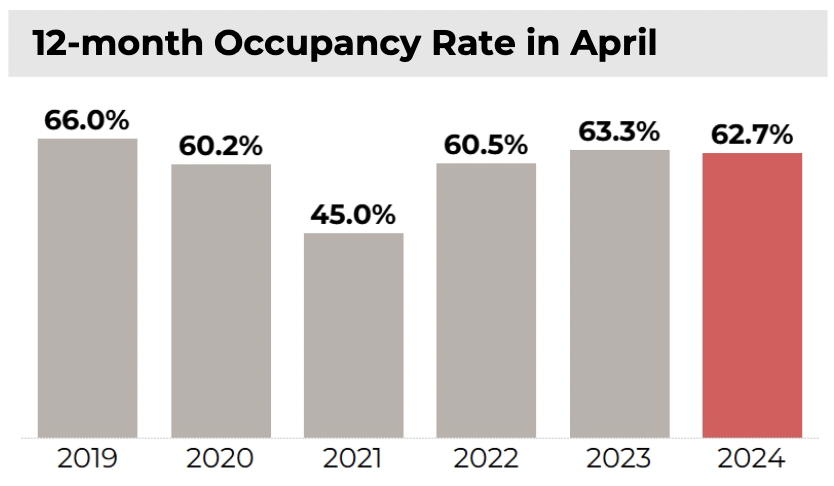May 2024 Commercial Real Estate Market Insights

The commercial real estate (CRE) market entered the second quarter of the year with persistently rising vacancy rates and slowing rent growth across most market sectors. Specifically, the office vacancy rate reached new record highs, approaching nearly 14%, while fundamentals in retail and industrial sectors decelerated. High interest rates and the effects of hybrid work on office spaces are the main factors that continue to hamper this sector. In the meantime, the U.S. economy started to slow down after previously exceeding expectations, reflecting the impact of inflation pressures on consumers.
Office Properties
At the beginning of the year's second quarter, fewer additional office spaces were vacated than occupied for the first time since the end of 2022. Even though net absorption remains negative with more vacated than occupied office spaces, this is the first time the gap between vacated and occupied office spaces has narrowed. However, the vacancy rate rose even further to 13.8% in April 2024. Looking ahead, the forecast suggests a persistent increase in available office spaces. Leasing activity, which helps to gauge the level of demand and interest from potential tenants, is about 30 percentage points below the pre-pandemic levels.
Multifamily Properties
On the other hand, high mortgage rates, hovering around 7%, continue to keep strong demand for apartment buildings. The multifamily sector not only rebounded from the lows it experienced last year, but net absorption is more than double that of the same period a year ago. This translates to more than twice of the additional occupied rental units than vacated compared to last April. Nevertheless, even with this strong demand, the vacancy rate remained at 7.8%. This is mainly due to the influx of new rental housing supply entering the market after the record highs in apartment construction over the past couple of years. The completion of these additional rental units has absorbed the higher demand and prevented vacancy rates from easing.
Retail Properties
Demand for retail spaces remained below the pre-pandemic levels as net absorption slowed further in April. Compared to a year ago, net absorption is significantly lower by approximately 30 percentage points. However, the limited availability of retail spaces keeps vacancy rates low, hovering around 4%, the lowest rate among any other sector in the commercial real estate market. With new construction deliveries likely to diminish even further, the fundamentals of this sector are expected to remain solid in 2024.
Industrial Properties
The industrial sector couldn't escape the impact, with demand for industrial spaces also decelerating. Net absorption has dropped to levels not seen in over a decade. After reaching record-high levels at the end of 2021 and the beginning of 2022, fueled by the need for warehouse spaces to accommodate online shopping and e-commerce demands, net absorption is 63% lower than a year ago and 52% below the pre-pandemic average level. However, this sector continues to experience the fastest rent growth compared to any other sector in the commercial real estate market. Specifically, rents for industrial spaces are 4.7% higher than a year ago. The outlook for the industrial real estate market remains positive, driven by factors such as the lasting impact of e-commerce and robust construction spending.
Hotel Properties
As we move further into 2024, the hospitality industry is showing improvement. Hotel occupancy rates have stabilized around 63%, which is still about 3% below pre-pandemic levels. This suggests that full recovery may be elusive due to the rise of remote work tools like Zoom. However, average daily rates (ADR) and revenue per available room (RevPAR) now surpass pre-pandemic levels.
Categories
Recent Posts










5966 Fairview Rd, Suite 400, Charlotte, NC, 28210, United States





